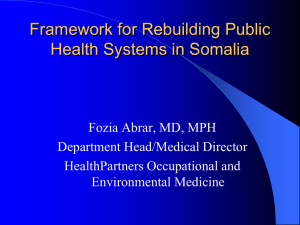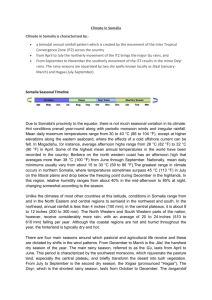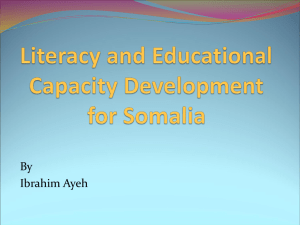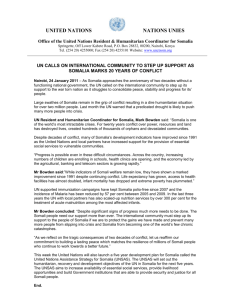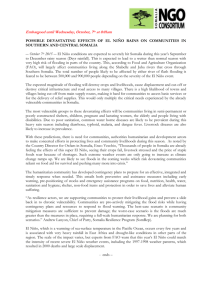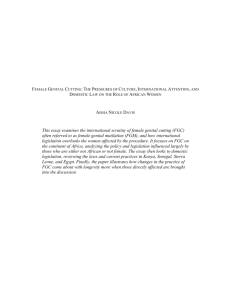Tackling female genital cutting in Somalia
advertisement
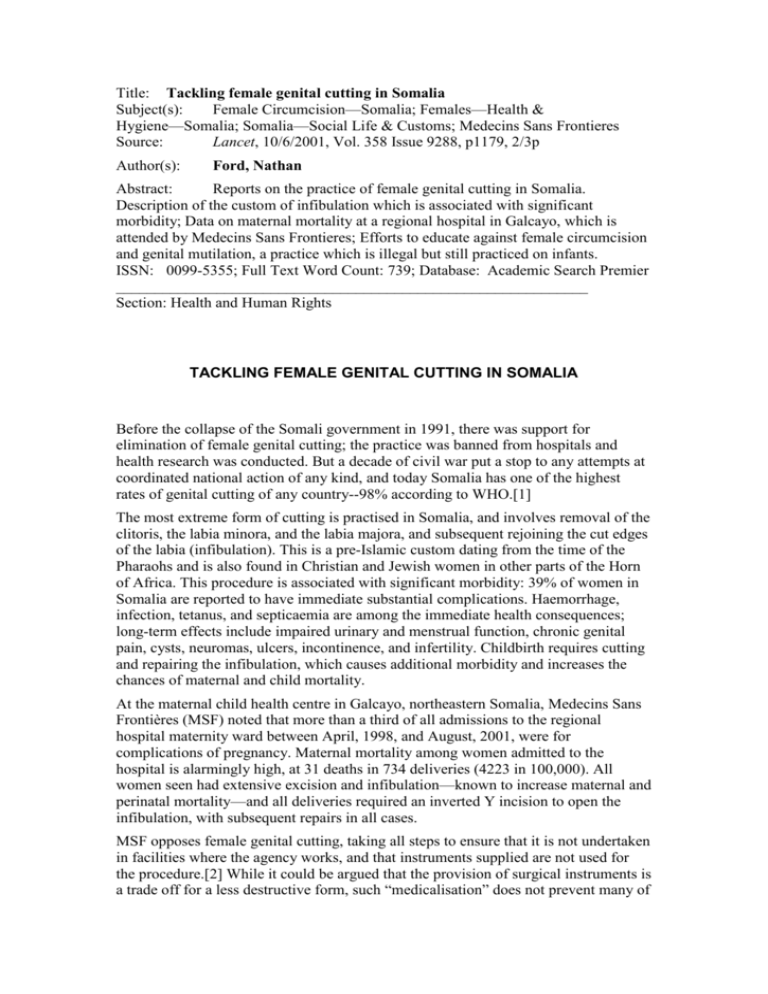
Title: Tackling female genital cutting in Somalia Subject(s): Female Circumcision—Somalia; Females—Health & Hygiene—Somalia; Somalia—Social Life & Customs; Medecins Sans Frontieres Source: Lancet, 10/6/2001, Vol. 358 Issue 9288, p1179, 2/3p Author(s): Ford, Nathan Abstract: Reports on the practice of female genital cutting in Somalia. Description of the custom of infibulation which is associated with significant morbidity; Data on maternal mortality at a regional hospital in Galcayo, which is attended by Medecins Sans Frontieres; Efforts to educate against female circumcision and genital mutilation, a practice which is illegal but still practiced on infants. ISSN: 0099-5355; Full Text Word Count: 739; Database: Academic Search Premier _____________________________________________________________ Section: Health and Human Rights TACKLING FEMALE GENITAL CUTTING IN SOMALIA Before the collapse of the Somali government in 1991, there was support for elimination of female genital cutting; the practice was banned from hospitals and health research was conducted. But a decade of civil war put a stop to any attempts at coordinated national action of any kind, and today Somalia has one of the highest rates of genital cutting of any country--98% according to WHO.[1] The most extreme form of cutting is practised in Somalia, and involves removal of the clitoris, the labia minora, and the labia majora, and subsequent rejoining the cut edges of the labia (infibulation). This is a pre-Islamic custom dating from the time of the Pharaohs and is also found in Christian and Jewish women in other parts of the Horn of Africa. This procedure is associated with significant morbidity: 39% of women in Somalia are reported to have immediate substantial complications. Haemorrhage, infection, tetanus, and septicaemia are among the immediate health consequences; long-term effects include impaired urinary and menstrual function, chronic genital pain, cysts, neuromas, ulcers, incontinence, and infertility. Childbirth requires cutting and repairing the infibulation, which causes additional morbidity and increases the chances of maternal and child mortality. At the maternal child health centre in Galcayo, northeastern Somalia, Medecins Sans Frontières (MSF) noted that more than a third of all admissions to the regional hospital maternity ward between April, 1998, and August, 2001, were for complications of pregnancy. Maternal mortality among women admitted to the hospital is alarmingly high, at 31 deaths in 734 deliveries (4223 in 100,000). All women seen had extensive excision and infibulation—known to increase maternal and perinatal mortality—and all deliveries required an inverted Y incision to open the infibulation, with subsequent repairs in all cases. MSF opposes female genital cutting, taking all steps to ensure that it is not undertaken in facilities where the agency works, and that instruments supplied are not used for the procedure.[2] While it could be argued that the provision of surgical instruments is a trade off for a less destructive form, such “medicalisation” does not prevent many of the serious health consequences, and is no less a violation of human rights; the practice contravenes human rights laws and conventions, including the Universal Declaration of Human Rights, the Convention on the Elimination of All Forms of Discrimination Against Women, the Convention on the Rights of the Child, and the African Charter on Human and People’s Rights. MSF has joined forces with women’s groups in Somalia. Health education about female genital cutting, delivered through training given to midwives and traditional birth attendants, has met with some success in parts of the Galcayo community: cutting is now talked about openly as a reason for problems in childbirth. Traditional birth attendants are aware of the health effects and several have said that they would be glad to see the practice stopped; furthermore, the local ministry of health has made infibulation illegal but there is no enforcement of the law. However, birth attendants say that most parents continue to ask for their infants to undergo the larger excisions. Parents who are more aware of the health issues or of the requirements of Islam do not have their daughters infibulated, but they remain a minority. The practice of female genital cutting is centuries old and persists because it satisfies the interests of people in the societies within which it is practised. Advocacy directed towards eradicating the practice is a cultural negotiation in which the language used is important. It has been suggested that calling the practice mutilation might antagonise the population against any initiative. “Is it helpful”, asks one Islamic scholar “to tell a mother that she is mutilating her daughter, or is it better to say that this cutting is harmful because of the health consequences?”[3] A focus on the health consequences provides a fairly uncritical and culture-neutral framework for discussion. Health workers must continue to record women’s experiences and use this information to advocate for change at various levels to work towards eradicating the practice. Notes 1. WHO. Female genital mutilation, an overview. Geneva: WHO, 1998. 2. Female genital cutting policy paper. Amsterdam: MSF, 1999. 3. Abdullahi An-Na’im. In: Ford N, Bedell R, eds. Intentions and consequences: human rights, humanitarianism and culture. Amsterdam: MSF, 1999. By Nathan Ford, Médecins Sans Frontières, 124-132 Clerkenwell Road, London EC1R 5DJ, UK _____ Copyright of Lancet is the property of Lancet and its content may not be copied or emailed to multiple sites or posted to a listserv without the copyright holder’s express written permission. However, users may print, download, or email articles for individual use. Source: Lancet, 10/6/2001, Vol. 358 Issue 9288, p1179, 1p Item: 5284078

